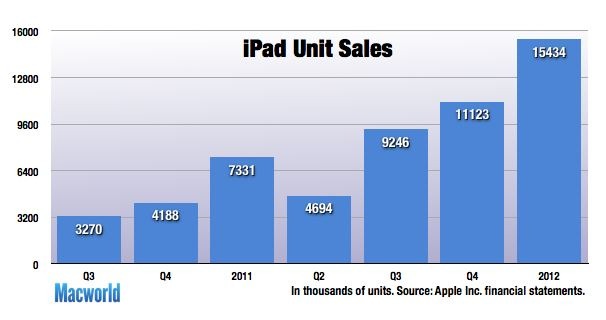One of the graphs posted in yesterday’s blog showed the number of people searching for IPad Help.
Here is the graph:
For a product that “just works”, there is an increasing number people searching the Web for iPad Help. However, part of that increase can be put down to the increasing number of iPad sales:

What we can conclude is that even users of products as simple and intuitive to use as the iPad search the Web for Help on how to use it. If you decide not to provide that Help, then users are likely to get the information from someone else – either in a forum, a YouTube video, blog, Web site etc. Places generally, outside of your control.

Hi Ellis. Two questions:
1. Are you suggesting that it is a bad thing that users would get help from a source outside your control? Such sources cost you nothing, and you incur no liability for their content. Also, they are likely to answer the kinds of offbeat and obscure questions you might not have thought of or had time to address in documentation. What is the downside of letting your customers help each other?
2. Is that any reason to believe that if you did supply documentation that people would read it in preference to Googling? I think Google-first is increasingly the default option for many. It certainly is for me. I simply have a much higher confidence that I am going to find an answer on Google rather than in documentation, which often tends to cover all the stuff I could figure out for myself and nothing I couldn’t.
Hi Mark
1. Are you suggesting that it is a bad thing that users would get help from a source outside your control?
In some cases, yes. That’s because the information may not be accurate, or it may cast your product in a unfavourable light. I’ve suggested in the past that if your competitors have missing documentation, then you should write it for them, comparing their product to yours(!) If I remember correctly, Anne Gentle suggested in her book that it’s generally best if you host the forum for user generated content.
2. Is that any reason to believe that if you did supply documentation that people would read it in preference to Googling?
If your content is on the Web, then when they searched Google there’s a good chance they would land on your Help. Technical Authors should be publishing their Help to the Web; then it can be found and they can measure how many people are reading it, and do all manner of analytics on the value of their work.
There is also a demand for paper manuals on the iPad, if the front display shelves at the bookshop in Heathrow Terminal 5 are anything to go by .
Hi Ellis,
I’m with you entirely on putting documentation on the web. Because people increasingly Google first, putting docs on the web is the best way to get them in front of your customers.
But, as Tom Johnson argued recently, the presence, and thickness, of documentation can suggest that your product is difficult to use. (http://idratherbewriting.com/2012/10/01/exploring-the-tech-comm-paradox/). Suggesting that the product is so easy to use that it does not require documentation has been a big part of Apple’s marketing strategy since the early Mac days. I can remember an early Mac commercial that compared the raft of binders that came with early PCs to the slender volume that shipped with the Mac.
For the moment, at least, this approach seems to be paying off for them. And it is not hard to see why. Many, if not most, consumers feel that they should not have to read documentation to use a product. No-documentation-required is a legitimate marketing stance. And even if it is not true that no documentation is required, it may be a more effective marketing strategy to maintain the fiction, ship no docs, and leave it to the aftermarket to supply the docs that people actually need.
A sobering thought for tech writers, to be sure, but ubiquitous connectivity is driving a sea change in the tech industry, and I don’t think we can be blind to its impact. Shipping no docs and letting the community help the community is a strategy that is being increasingly and successfully adopted. It’s pretty hard to argue against the marketing strategy behind the iPad.
I also agree that “documentation by the inch” is not a good idea. There is, however, a difference between minimal documentation and no documentation, and there are some who believe you can design away the need for any documentation.
With regard to ubiquitous connectivity, you have also picked up on the need for documentation for the users who want to connect a product to something else. Apple is possibly unique in having so much control over its “eco-system”, something others may not have.
We are also talking about products that are “non-technical”. We (Cherryleaf) have argued before that these types of products require a different type of user documentation (including a different writing style) to more traditional technical products.
There is a danger with products that “just work” that they simply become a commodity. If you are a commodity, you’re competing on price and possibly brand image. If the organisation does not want to be in that market space, then they need to differentiate. That may mean adding more features to the product, and these may not be as obvious to the users. Which may bring you back to a need to explain functionality to users. Apple has a great brand image and is very good at designing usable products. However, very few organisations are like Apple and able to replicate their recipe for success.
Maybe it is just me, but I find the bookstore display hilarious! Why anyone would buy a traditional paper manual on how to use the Ipad instead of the same content in Epub or PDF format….beats me.